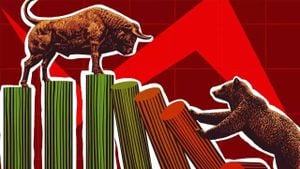NEW DELHI — The air quality crisis has taken center stage once again in India's capital, with authorities stepping up measures to combat severe pollution levels. Just this Monday, the government imposed stricter regulations including bans on diesel trucks and directives for employees to work from home if their jobs were non-essential. This response follows alarming reports as the Air Quality Index (AQI) dramatically soared to 484, categorizing it as 'severe plus' and marking the worst level observed this year.
People within the city felt the immediate impact of the smog, with traffic visibility plunging to just 100 meters (about 110 yards). Yet, flights and trains continued to operate, albeit with some delays. Even under these conditions, high school students were still required to physically attend school, leading to concerns among parents who watched their children walk through thick, unmasked smog.
The situation worsened as the air quality hit staggering figures—New Delhi topped the world's pollution rankings, according to the Swiss air quality monitoring group IQAir, with PM2.5 levels recorded at 130.9 times higher than the World Health Organization's safety guidelines. PM2.5 consists of fine particulate matter capable of penetrating the lungs and triggering serious health complications, creating urgency for parents and public health officials alike.
Indian authorities recognized the need for action, citing seasonal factors as exacerbators of the air quality issues. Each winter, Delhi faces issues like crop stubble burning, along with emissions from vehicles and construction sites. The government had hoped to mitigate pollution by banning non-essential vehicles and shutting down schools.
While the government moved to implement these measures, experts raised concerns about their timeliness and effectiveness. Authorities directed all schools to move to online classes, covering primary and secondary education. All other non-essential construction activities across the National Capital Territory (NCT) were also halted indefinitely. This action aimed to prevent the air from deterioring beyond its current hazardous level.
Comments from locals provide insight on the ground-level impacts of such pollution. Subodh Kumar, a 30-year-old rickshaw puller, described the daily struggle, stating, "My eyes have been burning for the last few days. Pollution or no pollution, I have to be on the road; where else will I go?" This echoes the sentiments of many residents who are left vulnerable, unable to afford air filters or housing outfitted to keep the toxic pollution at bay.
The pollution crisis was aggravated by the recent spike in farm fires as thousands of hectares of stubble were set alight to clear the fields post-harvest. Reports indicated the most significant number of fire incidents detected via satellite readings across six Indian states, demonstrating the large scale of the pollution problem. More than 40 percent of the air quality crisis can be attributed to these agricultural practices according to the SAFAR weather agency.
Visibility continued to deteriorate as the thick smog crept across the city, prompting officials to heighten their calls for residents to stay indoors, particularly during peak pollution hours. India's Supreme Court highlighted the pressing need for action by reinforcing the notion of clean air being fundamental to human rights and urging governments to address the persistent air quality challenges.
With Delhi being home to over 30 million people, the city's myriad challenges surrounding air pollution and health call for comprehensive and sustainable solutions. Experts and activists have long argued for systemic changes rather than temporary measures. They advocate adopting technological innovations alongside strict enforcement of pollution regulations, particularly as dense winter fog and stagnant air contribute to trapping pollutants.
For now, the government's response exists as both urgent and complex: addressing the acute level of pollution, safeguarding public health, and implementing effective long-term strategies. Residents and officials alike know this is more than just another smog season. It embodies the continuous struggle against the perennial issue of air pollution, which has long haunted India's sprawling urban centers.
Looking forward, experts suggest concerted efforts from various sectors, including agriculture, transportation, and urban planning, to fundamentally change the air quality dynamics. Collaborative actions are needed if New Delhi hopes to emerge as not just the world’s capital, but also as an example of urban sustainability.



